Types of Buckeye Trees with Their Flowers and Leaves – Identification Guide (Pictures)
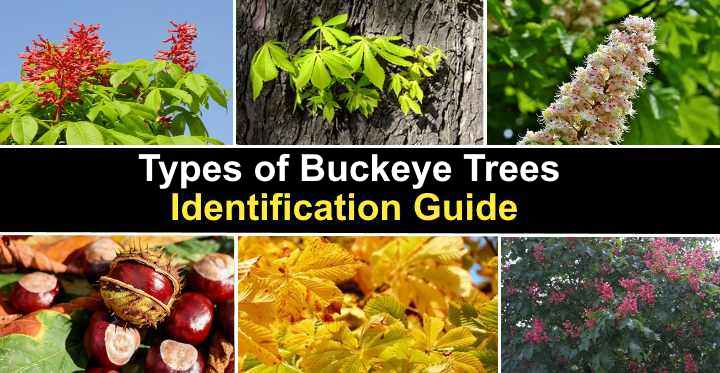
Buckeyes (Aesculus) are a species of large deciduous tree that is related to the horse chestnut tree. Common varieties of buckeyes are the Ohio buckeye, the California buckeye, and the yellow buckeye. Buckeye trees are identified by their large round inedible nut-like seeds, green palmately compound leaves, and creamy-yellow or red flower clusters.
Buckeyes are excellent ornamental trees for medium to large backyards. The tall trees with their leafy green foliage provide plenty of shade. With their conical flower panicles and vibrant orange fall colors, buckeyes are trees with plenty of seasonal interest.
This article is a guide to identifying the most common types of buckeyes. Descriptions of the tree’s leaves and flowers, along with pictures of buckeye trees, will help to recognize the most common species. At the end of the article, you’ll find out how to care for these native trees.
What are Buckeyes?
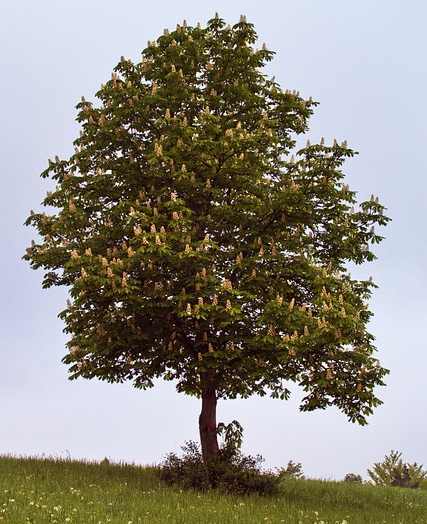
Buckeyes are deciduous ornamental trees that are popular in parks and open spaces
Buckeye is a variety of ornamental trees in the genus Aesculus and family Sapindaceae. There are four main varieties of buckeye trees. The most popular buckeye is the species Aesculus glabra, or Ohio buckeye tree. Buckeyes are common trees in North America.
Buckeye trees grow between 12 and 40 ft. (3.5 – 12 m) tall. You can find buckeyes growing in the deciduous forests and grasslands in the Midwest. They are also popular trees in parks and open spaces in states along the East Coast and the Southern states. Ohio buckeyes are found all the way from New York to Kentucky and down to Texas.
Buckeyes get their name from the tree fruit—a round chestnut-like seed that looks like the eye of a buck. As the common name suggests, the Ohio buckeye is the state’s national tree. The term “buckeyes” can refer to people from Ohio or graduates of Ohio State University. Buckeyes are also a name for candy that looks like the buckeye tree’s seed.
About the Buckeye Nut (Buckeye Seed)
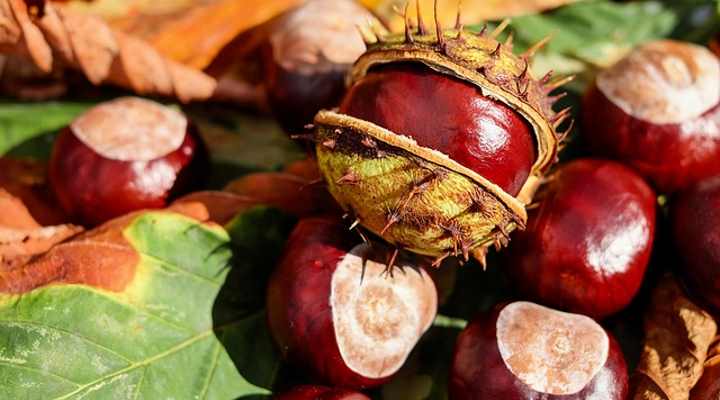
The nut-like seed of buckeyes is toxic to humans and animals
Fruit from buckeye is a rounded, oval, shiny brown nut-like seed with a cream-colored round circle. The round seeds are about 1.2” (3 cm) in diameter and look like chestnuts. Buckeye tree’s nuts are toxic to humans and animals and shouldn’t be eaten. The buckeye fruits are only used for crafts and their decorative value.
Buckeye seeds are said to bring good luck. Ohio state folklore says that carrying a buckeye seed in your pocket will result in good fortune. The lucky buckeye should stay in your pocket where you can rub it between your finger to ensure good luck or for an auspicious outcome.
Because of the tree’s popularity, Ohio is also known as the Buckeye State.
Buckeye Leaves
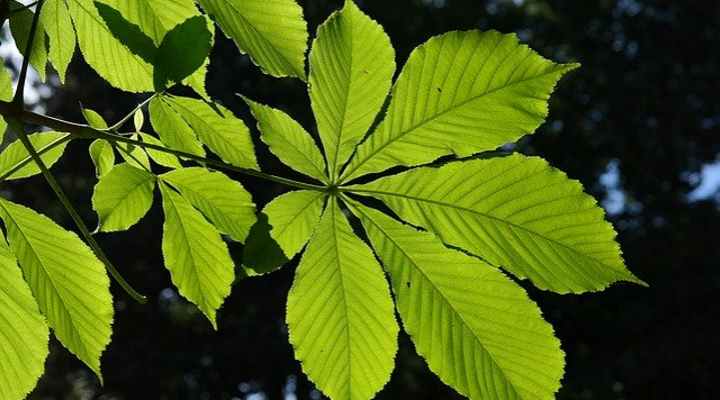
Buckeye tree leaves
Buckeye leaves are palmately compound leaves made up of five to seven leaflets. Each leaflet is an elliptic or ovate shape and grows between 3” and 12” (8 – 30 cm) long. The individual elliptical leaves have finely toothed margins. Depending on the buckeye species, tree leaves can be light to dark green color.
Buckeye Flowers
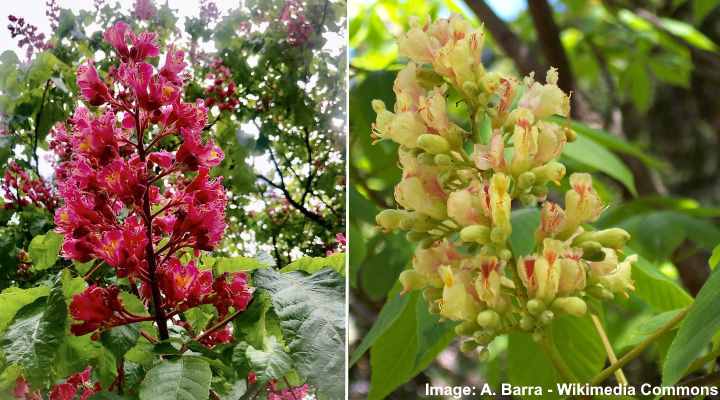
Left picture: flowers of red buckeye (Aesculus pavia). In the right picture flowers of yellow buckeye (Aesculus flava)
The buckeye tree is a flowering tree species with conical clusters (panicles) of tiny flowers with creamy yellow to green petals. Other buckeye trees produce pink and red flowers. The panicles can contain around 80 flowers and grow up to 6” (15 cm) long.
In full bloom during April and May, the Ohio buckeye or California buckeye can have thousands of fragrant flowering panicles.
How to Identify a Buckeye Tree
To identify a buckeye tree, such as the Ohio buckeye, look at the tree’s seeds, leaves, and flowers.
The easiest way to identify buckeye trees (Aesculus) is by the buckeye nuts. The round fruits are encased in a brown husk with spines. The shiny brown seeds have a deep brown color and whitish round patch—like a deer’s eye.
Buckeye leaves are identified by the five or seven leaflets arranged in a semicircle at the end of a long stalk. Most Ohio buckeyes have five leaflets with pointed tips, and the yellow buckeye often has seven ovate-shaped leaflets.
All Parts of The Buckeye Tree are Poisonous
Buckeyes seeds, stems, leaves, and bark all contain toxins. Because of its toxicity, you shouldn’t eat any part of the Ohio buckeye or other buckeye species. The only way to use these inedible buckeye seeds is in crafts.
The US Department of Agriculture (USDA) says that ingesting any part of buckeye plants can cause severe gastrointestinal upset, muscle weakness, and paralysis.
Buckeye seeds, leaves, and bark are also poisonous for cats, dogs, and livestock. Ingesting the poisonous seeds causes similar symptoms as for humans—vomiting, diarrhea, convulsions, and even coma.
Interestingly, squirrels can eat raw buckeye nuts and are one of the few animals that can do so.
What is the Difference Between Buckeyes and Horse Chestnuts?
The main difference between buckeyes and horse chestnuts is their height, number of seeds, and leaf size. Both horse chestnuts and buckeyes belong to the same tree genus Aesculus. However, buckeye trees are native to North America, and horse chestnuts come from Europe.
Here are a few ways to tell the difference between buckeyes and horse chestnuts:
- Seeds—Mature buckeye seeds are surrounded by a brown, not green, husk. There is usually only one seed in each buckeye pod—horse chestnuts can have up to four. However, some buckeye varieties have seed capsules with two or three nuts.
- Leaves—Buckeye leaves are usually narrower than horse chestnuts and have a more elongated shape.
- Tree height—Buckeye trees are smaller than horse chestnut trees and grow to about 40 ft. (12 m) high. Horse chestnuts grow up to 100 ft. (30 m) tall.
It’s important to know that neither buckeyes nor horse chestnuts are related to the edible chestnut in the genus Castanea. Edible chestnuts always have a pointed end with a tassel, whereas buckeye nuts are rounded and smooth.
Types of Buckeye Trees (With Pictures)
Let’s look in detail at the most popular varieties of buckeye.
Ohio Buckeye (Aesculus glabra)
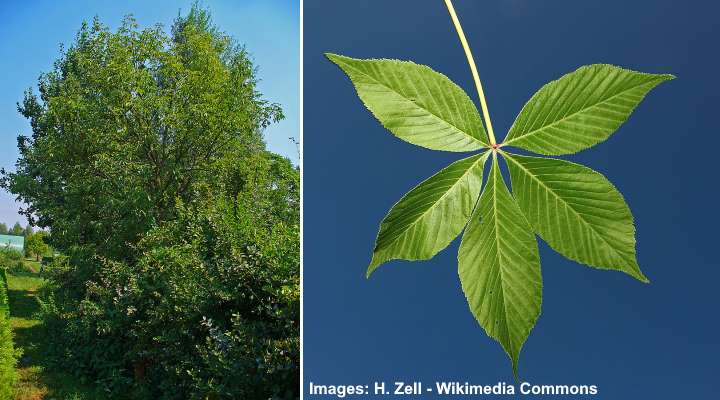
Ohio buckeye tree (left) and leaves (right)
The Ohio buckeye is a popular ornamental flowering tree with a rounded crown and dense, dark green leafy foliage. The pinnate compound leaves are made up of five long, lanceolate leaves. You can identify this tree in spring by the conical clusters of yellowish-green flowers.
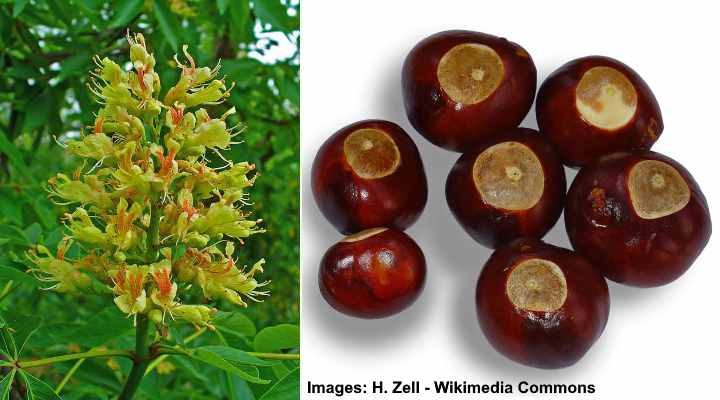
Ohio buckeye flowers (left) and seeds (right)
Ohio buckeye (Aesculus glabra) grows between 20 and 40 ft. (6 – 12 m) tall. You’ll find this Aesculus species growing in states from Pennsylvania to Alabama.
Ohio buckeye bark is gray with a rough texture that becomes scaly as the tree ages.
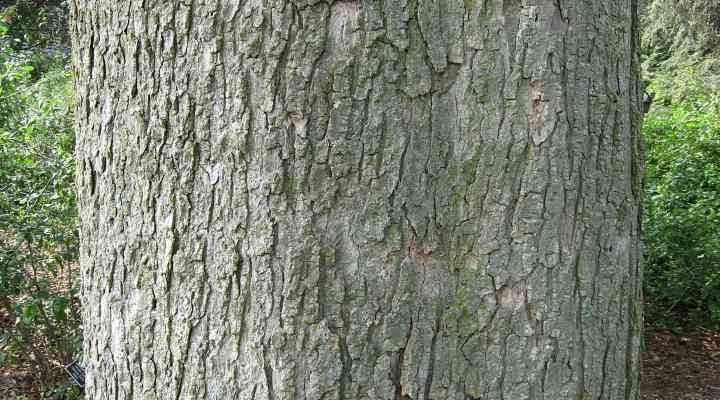
Ohio buckeye bark
Other names for the Ohio buckeye include American buckeye and fetid buckeye. The leaves can give off a strong offensive odor in the fall when crushed, which is why it also gets called the stinking buckeye.
After the Ohio buckeye finishes flowering in late spring, prickly round capsules grow on the tree. Each of these chestnut-like fruits contains a shiny mahogany brown buckeye seed. You can use the seeds to plant new Ohio buckeye trees. Or you can keep an Ohio buckeye nut in your pocket to see if it brings good luck.
Ohio buckeyes grow best as attractive landscape trees in large lawns or as shade trees in parks.
Buckeye flowers: Ohio buckeye flowers are conical clusters of cream-colored or greenish-yellow flowers. These pyramid-shaped panicles are between 4” and 7” (10 – 17 cm) long and grow at the end of branches.
Buckeye leaves: Ohio buckeye tree leaves are arranged like fingers on a hand. The five lanceolate leaflets grow between 3” and 6” (7.5 – 15 cm) and have finely serrated edges. The buckeye leaves are dark green in summer and turn bright yellow or orange in the fall.
Texas Buckeye (Aesculus glabra var. arguta)
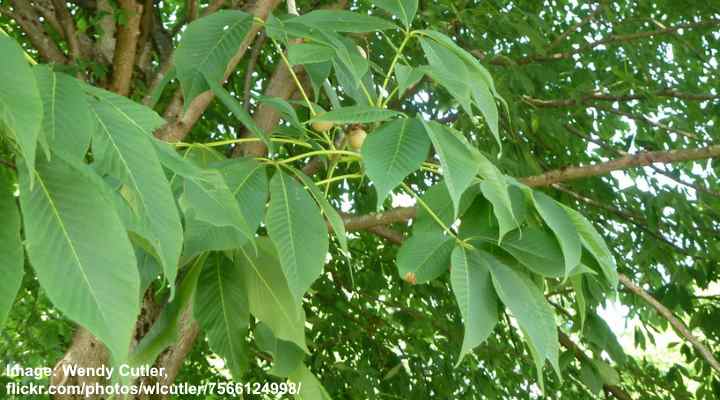
Texas buckeye leaves
The Texas buckeye is a variety of buckeye (Aesculus) that grows as a large shrub or small tree. Being a variety of the Ohio buckeye, this chestnut-like tree has similar characteristics. The Texas buckeye has large glossy green lanceolate leaflets with serrated edges make up the tree’s palmate leaves. The tree blooms in spring, and flowering spikes stand erect in conical clusters on the ends of branches. This variety of buckeye has a rounded crown with drooping branches.
Texas buckeye trees grow between 6 and 20 ft. (2 – 6 m) tall.
Buckeye leaves: Texas buckeye tree leaves consist of seven to nine leaflets. The smooth glossy green leaves grow up to 5” (12 cm) long. In the fall, the tree leaves turn a stunning orange to deep red color.
Red Buckeye (Aesculus pavia)
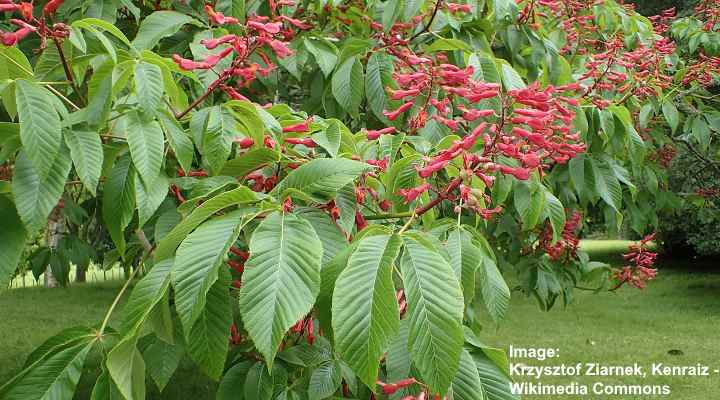
Red buckeye leaves and flowers
The red buckeye is one of the most spectacular ornamental deciduous trees, thanks to its vibrant red flowers. The red buckeye is a small landscape tree that has an oval crown, glossy dark green leaves, and red spring flowers. The red buckeye leaves are lance-shaped, and five leaflets make up the compound leaves.
Red buckeyes grow between 12 and 15 ft. (3.5 – 4.5 m) and thrive in full sun. Because of their shorter growth, this buckeye variety is suitable for residential backyards or small parks. Their dense foliage makes this an elegant shade tree for garden landscapes.
The outstanding feature of red buckeyes is their red flowers. These red panicles grow in spring and can measure up to 10” (25 cm) tall. The triangular red flower clusters contrast nicely with the dark green, leafy foliage.
Red buckeye (Aesculus pavia) nuts grow in soft brown capsules. There can be one to three shiny brown buckeye seeds in each pod.
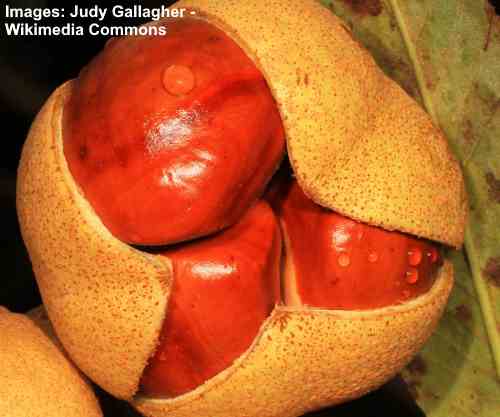
Red buckeye seeds
The Red buckeye (Aesculus pavia) is also called the scarlet buckeye, firecracker buckeye, and wooly buckeye. There is also the Aesculus pavia ‘Variegata’ variety.
Buckeye leaves: Red buckeye tree leaves are palmately compound and made up of elongated pointed leaflets. The leaves have no particular outstanding fall color before the leaves drop in late September.
Dwarf Red Buckeye (Aesculus pavia ‘Humilis’)
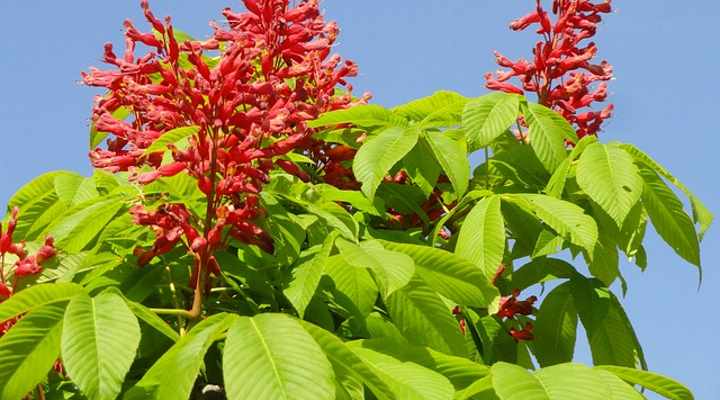
Dwarf red buckeye flowers and leaves
The dwarf red buckeye (Aesculus pavia ‘Humilis’) is a dwarf variety of the red buckeye tree. The dwarf red buckeye grows as a large shrub rather than a tree. Like the larger red buckeye, the dwarf variety has large palmate leaves that are light to dark green. Also, clusters of tubular deep-red flowers bloom in spring.
The dwarf red buckeye is a low-growing bushy shrub-like tree. This cultivar is perfect for small backyards if you want to grow a buckeye but don’t have space.
Buckeye leaves: Dwarf red buckeye shrub leaves comprise of five to seven leaflets that droop from the end of long stems (petioles). The ovate or lanceolate leaves have a pointed tip and a toothed margin.
Yellow Buckeye (Aesculus flava)
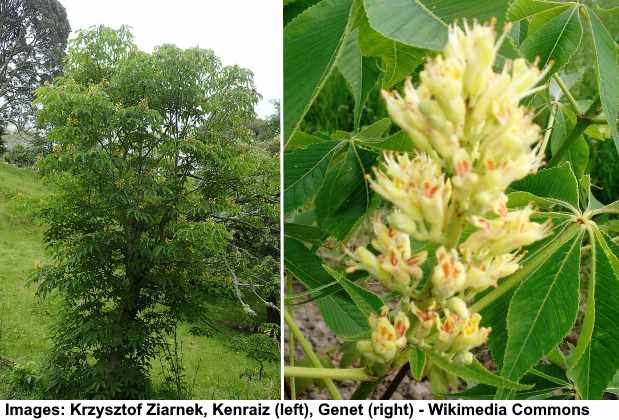
Yellow buckeye young tree (left) and flowers (right)
Yellow buckeye is native to Ohio and is an ornamental tree with showy, yellow flowers and vibrant fall colors. This buckeye’s rounded crown is made up of elongated, ovate leaves that droop from the stems. In spring, the tree blooms with clusters of yellow to yellow-greenish tubular flowers.
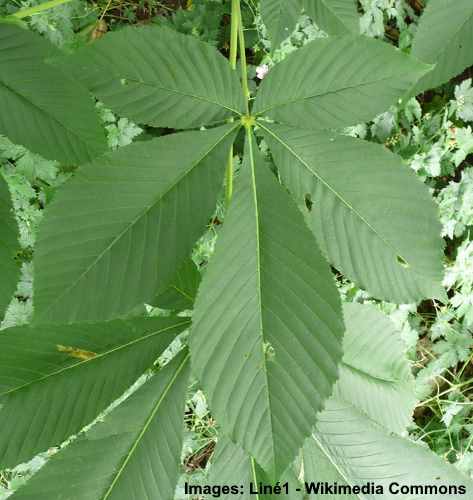
Yellow buckeye leaves
Yellow buckeyes are large trees growing between 50 and 75 ft. (15 – 22 m) tall and a spread up to 50 ft. (15 m). You can find yellow buckeyes growing in states from Pennsylvania to Alabama and Georgia.
Species of Aesculus flava produce globular fruits containing one or two seeds. The distinctive buckeye seeds are encased in smooth, leathery brown husks.
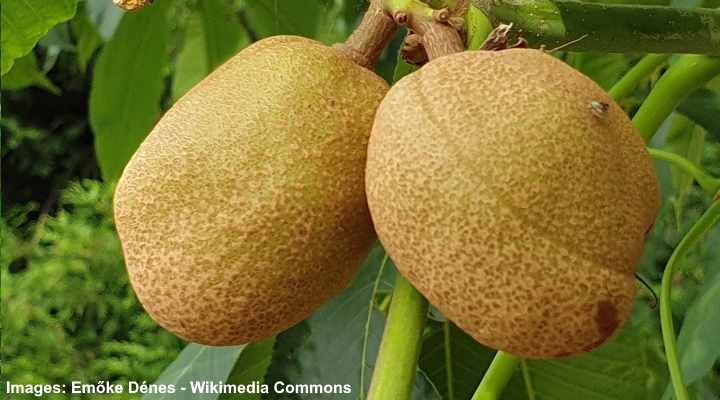
Yellow buckeye fruits
Buckeye leaves: Yellow buckeye leaves are palmate compound made up of five ovate-oblong leaflets. Each leaflet has serrated edges and grows between 4” and 7” (10 – 18 cm) long. The leaflets hang from the long petioles, adding to the tree’s attractiveness. The buckeye leaves turn bright orange in the fall.
Painted Buckeye (Aesculus sylvatica)
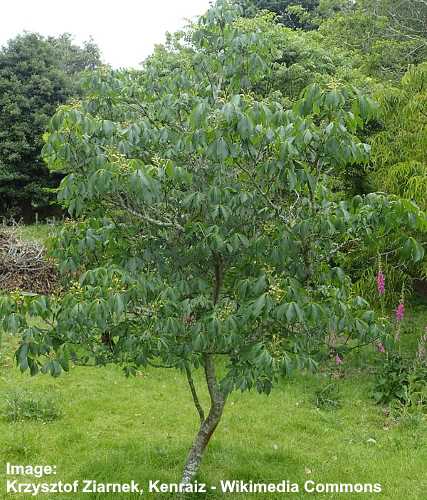
Painted buckeye tree
Also called Georgia buckeye, painted buckeye is a small deciduous ornamental tree with attractive colorful flowers and lovely green leaves. The leaves emerge in early spring in various red shades. Painted buckeye flowers can be different shades of yellows, pinks, or reds. The buckeye seeds are dark brown, and there are usually one to three in each leathery round capsule.
Georgia buckeyes grow between 6 and 15 feet (1.8 – 4.5 m) tall with a similar-sized spread. The common name of “painted” buckeye comes from the fact that the flower clusters resemble an upturned paintbrush.
Painted buckeye trees are among the first to grow leaves in spring and the first to drop them in early fall.
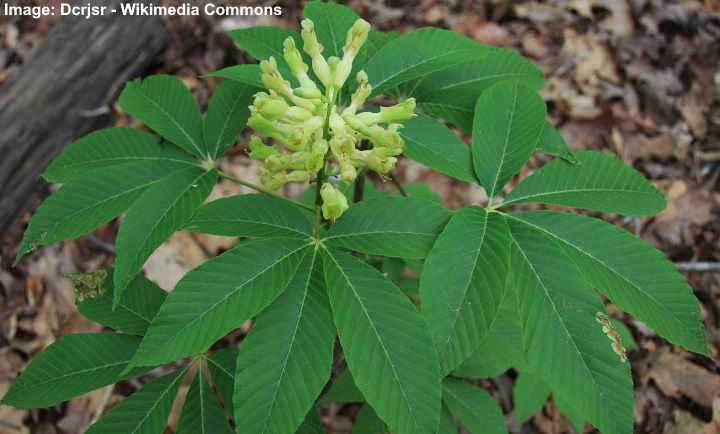
Painted buckeye leaves and flowers
Buckeye leaves: Painted buckeye leaves are smaller than other buckeye species. The five green leaflets grow between 4” and 6” (10 – 15 cm) long and dangle from the end of short stems. In fall, the leaves turn a yellow to orange color.
California Buckeye (Aesculus californica)
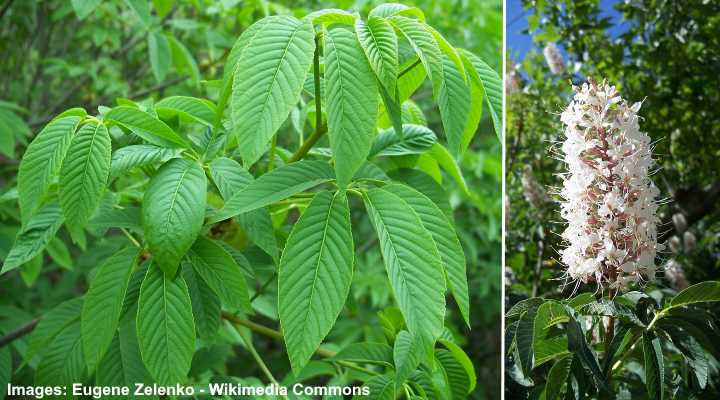
California buckeye leaves (left) and flower (right)
The California buckeye is a small tree with a slightly rounded, flattened crown, dense leafy foliage, and sweetly-scented white flower clusters. This buckeye species has attractive leaves made up of five to seven leaflets. The California buckeyes bark is pale silver, and its multiple stems give the tree a beautiful winter look.
California buckeyes grow between 15 and 30 ft. (4.5 – 9 m).
The outstanding feature of California buckeyes is their spectacular floral display. The large 12-inch (30-cm) flower clusters with spidery stamens give the panicle a fuzzy look. The erect creamy-white flowers growing on the rounded canopy make the buckeye look like a vast, spreading candelabra.
The buckeye nuts on Aesculus californica are an orangey-brown color, not the dark shiny mahogany of most buckeye seeds.
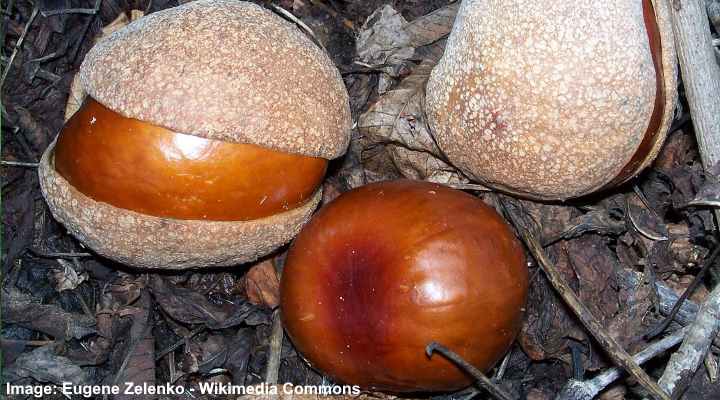
California buckeye nuts
Buckeye leaves: California buckeye tree leaves are shiny, dark green palmate leaves with five narrow lanceolate leaflets. Like most Aesculus species, the leaflets have toothed margins. The fall color foliage of these buckeyes is light pink to orangey-red.
Bottlebrush Buckeye (Aesculus parviflora)
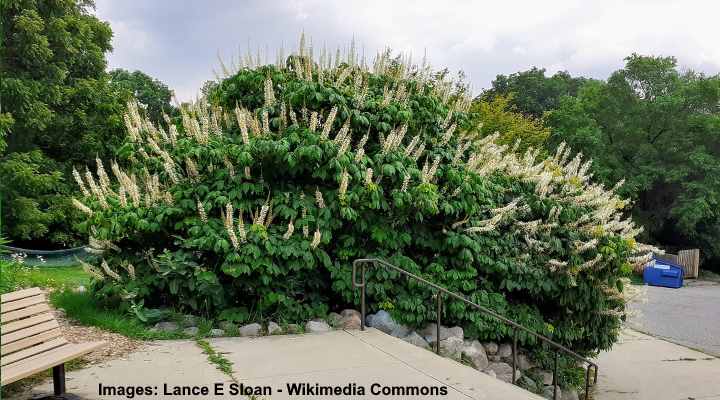
Bottlebrush buckeye shrub
The bottlebrush buckeye is the only true buckeye shrub. The bushy plant has multiple stems, packed with dense foliage made up of palmate leaves.
Bottlebrush buckeye has long white cylindrical flower panicles that are clusters of small tubular flowers that have a furry appearance. When in bloom in spring and early summer, the bottlebrush buckeye produces a stunning floral display.
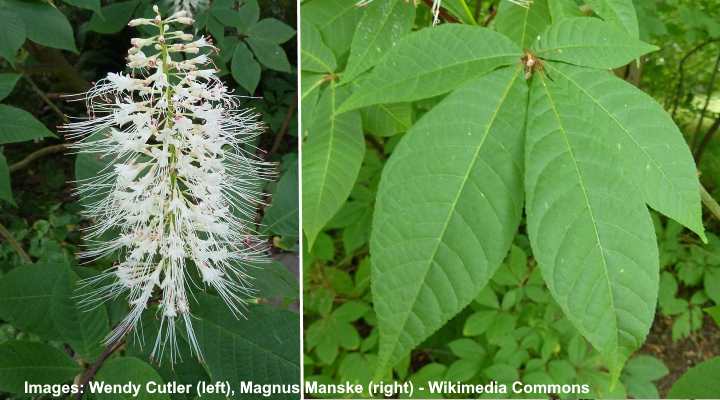
Bottlebrush buckeye flower and leaves
Bottlebrush buckeyes grow between 8 and 12 ft. (2.4 – 3.5 m) and spread to 15 ft (4.5 m) wide. The inedible buckeye nuts are pear-shaped and encased in yellowish husk.
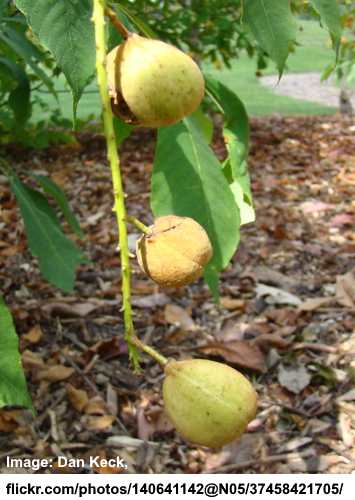
Bottlebrush buckeye nuts
Buckeye leaves: Bottlebrush buckeye shrub leaves are green palmate leaves containing five to seven stumpy lance-shaped leaflets. The dull, dark green leaves turn pale yellow in fall.
Buckeye Care
Growing buckeye trees is easy if you live in USDA zones 5 through 9. Buckeyes thrive in full sun or partial shade, and it’s vital to keep the soil reasonably moist. Plant in a location in your backyard that has good drainage. The best time to plant buckeyes is in spring or fall. However, it’s vital to ensure that you pick the right buckeye variety as they can grow into large shade trees.
To care for an Ohio buckeye or other buckeye variety, water mature trees only enough to keep the ground moist. Mulch around the trunk and root base to lock in moisture. Just remember to leave 3” or 4” (7.5 – 10 cm) free from the trunk to prevent root rot. Prune thin buckeye branches in spring to shape the tree.
Buckeyes are not common in residential gardens because they tend to be messy trees due to leaf drop and fallen seeds.
Related articles:
- Vitex Trees (Chaste Trees): Types & Care
- Types of Viburnum: Shrubs, Trees and Hedges
- Types of Eucalyptus Trees: Leaves, Flowers, Bark
